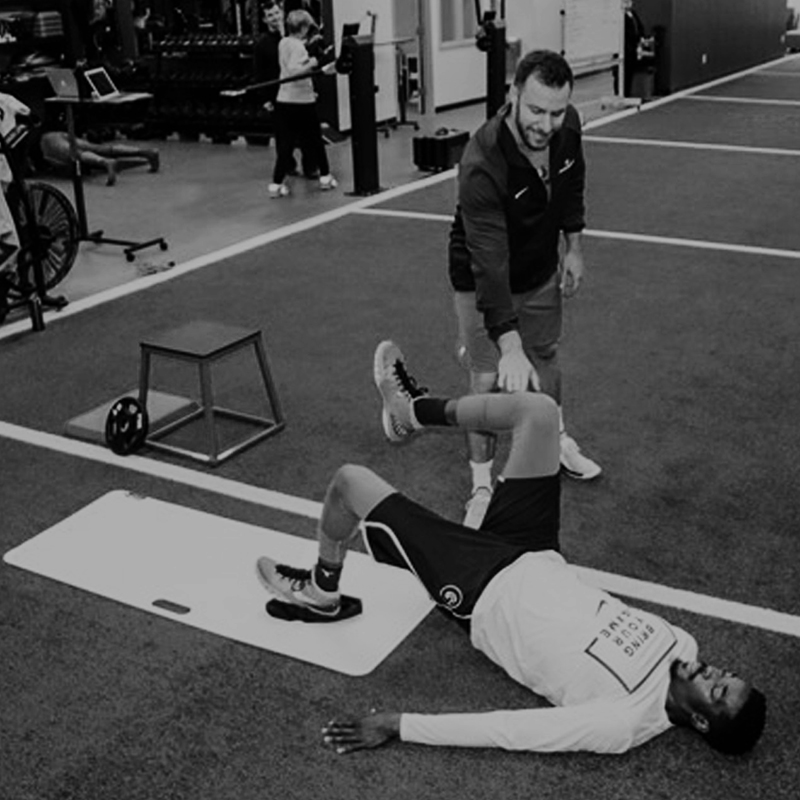
Injured athletes don’t need to rest, they need to train!!
This article will highlight some of the deleterious effects of immobilization through a quick research review summary and then provide some videos of training and work that I did with a patient who was non-weight bearing in an ankle cast and for 6 weeks following ankle ligament reconstruction.
On Disuse Atrophy: Muscle wasting begin almost immediately once an athlete goes into a cast or has a joint immobilized. When a joint can’t move, the muscles that cross it literally turn off and begin to shrink in size.
Research has consistently shown significant losses in muscle mass over relatively short periods of immobilization. In one recent study, five days of immobilization led to 3.5% reduction in quadriceps CSA (cross-sectional area) and 9% muscle strength. In the same study, there was a 8% decrease in muscle CSA and a 23% reduction in quadriceps strength after 14 days of immobilization. There multiple factors at play during disuse atrophy including central nervous system changes as well as muscle physiology.
The process of muscle atrophy is highly regulated and results in reduced protein content, reduced force production, increased fatigability and decreased insulin sensitivity, decreased capillary density of both fiber types and disruption of the 3-dimensional architecture of skeletal muscle. Skeletal muscle also undergoes a shift in contractile capacity of the fibers toward fast glycolytic phenotypes. For example, the soleus muscle which is predominantly composed of slow twitch fibers is a postural muscle and highly susceptible to disuse and fiber type switching.
https://www.ncbi.nlm.nih.gov/pmc/articles/PMC3955994/
Take Home Point
Rehab for the high level athlete should start the day they are injured. In addition to considering the injury site itself, I contend it is the job of the physical preparation staff (physical therapist, athletic trainer, strength coach, etc.) to find creative ways to support the athlete and their individual needs.
In addition to rehabilitating and protecting the injury itself, the ideal approach should expose the rest of the body to basic strength training and cardiovascular exercise. The goal is to preserve as much muscle mass and cardiovascular conditioning as possible. Why don’t we do this enough? Injured athletes don’t need to rest, they need to stay fit. This helps to ensure a safe return to sports and reduce the learning curve of “getting back into shape” after an injury.
In addition to the reduction in maladaptations, helping injured athletes continue to exercise can have an positive psychological effect. The link between season ending or catastrophic injury and depression is real. Keeping athletes active and motivated may help them not lose their identity as an athlete.
Here is a case study and series of videos I took working with a high school basketball player last year. She had ankle ligament reconstruction following a traumatic ankle sprain that ended her season early. Once she got out of her cast and then boot, it was incredible. This particular athlete recovered as fast as I’ve seen for a lower extremity injury that was non-weight bearing / immobilized. As you will see in the videos, she worked her tail off. She came in twice per week and did a ton of home exercises as well. She was back on the court playing basketball (not full contact yet!) 6 months after her surgery.
-Videos-
Exercises for the injured leg
Standing Band Kick Backs
Standing Band Press Downs
I typically use the band kickdown in a cyclical motion to mimic frontside sprint mechanics and emphasize the hamstring / posterior chain lengthening. If done with greater than 90 degrees knee flexion and a pistoning motion, it turns into a more quad and glute dominant movement.
Standing Band Single Leg Knee Drive
Standing Band Single Leg Knee Drive (foot elevated on box)
Sidelying Hip Abduction w/Ankle Weight
Form notes on this exercise: she has her toe pointed slightly down to ensure maximal glute activation and not hip flexor activation. She also is going below parallel and into relative hip adduction. Hip adduction increases the stretch on the hip abductors and external rotators while giving some glute max extension fibers an abduction moment arm. This is a sweet glute exercise.
Exercises for the non-injured leg
Box Pistol Squat
This is an exercise you can do to take advantage of the crossover effect and train the non-injured limb. This athlete is currently non-weight bearing on her surgical leg status post ankle ligament reconstruction.
Core Exercises
It’s important to note that core exercises are working the injured and non-injured leg. During a plank the quadriceps and hip flexors are being used as prime movers to isometrically drive anti-knee extension and anti-hip flexion. The glutes, adductors, and other hip muscles are being recruited at a lower level as well.
Plank + Body Saw on Foam Roller
This exercise should be done in later weeks of recovery (weeks 3-6 after surgery) as I prefer to not load the ankle in any way early on in recovery. It should be progressed with holds for small periods of time at first to watch for any post exercise surgical site soreness.
Ab Roll Outs (with range of motion block)
Cardiovascular Exercise
Rowing
I have the rower resistance turned all the way down because this athlete is not accustomed to rowing. She has her cast in a cloth slideboard booty and surgical leg on a slide board. There is no pressure on the surgical leg: it’s just along for the ride. I recognize her form is not ideal, but we found this to be the absolute best way for her to boost her heart rate. Remember, inefficient exercise can elicit a large cardiovascular tax.
The goal here is to provide quick bursts of cardiovascular effort that are helping her to maintain an aerobic base as well as her alactic and anaerobic energy system base.


